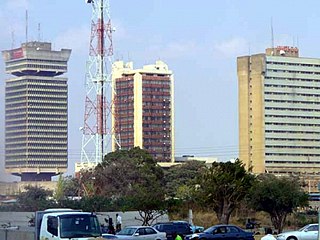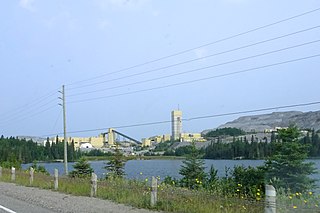
Zambia is a developing country, and it achieved middle-income status in 2011. Through the first decade of the 21st century, the economy of Zambia was one of the fastest-growing economies in Africa, and its capital, Lusaka, the fastest-growing city in the Southern African Development Community (SADC). Zambia's economic performance has stalled in recent years due to declining copper prices, significant fiscal deficits, and energy shortages.

Barrick Gold Corporation is a mining company that produces gold and copper with 16 operating sites in 13 countries. It is headquartered in Toronto, Ontario, Canada. It has mining operations in Argentina, Canada, Chile, Côte d'Ivoire, Democratic Republic of the Congo, Dominican Republic, Mali, Papua New Guinea, Saudi Arabia, Tanzania, the United States and Zambia. In 2019, it produced 5.5 million ounces of gold at all-in sustaining costs of $894/ounce and 432 million pounds of copper at all-in sustaining costs of $2.52/pound. As of 31 December 2019, the company had 71 million ounces of proven and probable gold reserves.

First Quantum Minerals is a Canadian-based mining and metals company whose principal activities include mineral exploration, development and mining. Its main product is copper, which accounts for 80% of revenues as of 2016.
Newmont Corporation is an American gold mining company based in Greenwood Village, Colorado. It is the world's largest gold mining corporation. Incorporated in 1921, it owns gold mines in Nevada, Colorado, Ontario, Quebec, Mexico, the Dominican Republic, Australia, Ghana, Argentina, Peru, and Suriname. In addition to gold, Newmont mines copper, silver, zinc and lead.
Antofagasta plc is a Chilean multinational. It is one of the most important conglomerates of Chile with equity participation in Antofagasta Minerals, the railroad from Antofagasta to Bolivia, Twin Metals in Minnesota and other exploration joint ventures in different parts from the world. Antofagasta is listed on the London Stock Exchange and is a constituent of the FTSE 100 Index.

Mazabuka is a town in the Southern Province of Zambia. It is the capital of Mazabuka District, one of the thirteen administrative units in the Southern Province. The name Mazabuka originates from a Tonga local language word "kuzabuka" which means "To cross over the river". The name should have been "mwazabuka" which translates to "you have crossed". However, due assimilation, the name became "Mazabuka" which nonetheless translates to "you have crossed". It is believed that the name was coined after the Tonga people crossed the Kafue River near a place called Nanga during their migrations.
NOVAGOLD is a Canadian company that is pursuing the development of the Donlin Gold mine in Alaska. Headquartered in Vancouver, the company is listed on the NYSE American and the Toronto Stock Exchange. The company was founded in Dartmouth, Nova Scotia, in 1984, to pursue exploration and development of mining properties. While the company bought and sold numerous exploration rights across North America, they have principally focused on four properties. They developed and operated the Murray Brook Mine in Nova Scotia from 1989 to 1992 and developed the Rock Creek Mine in Alaska but defaulted on financial obligations forcing it to close shortly after opening in 2008. They conducted exploration and development work on the Galore Creek mine in British Columbia between 2003 and 2018 but sold its interests. The development of the Donlin Gold mine has been pursued since the formation of a joint venture with Barrick Gold in 2012.

The Bank of Zambia (BoZ), is the central bank of Zambia.

The Lusaka Stock Exchange is the principal stock exchange of Zambia. Founded in 1993, it is located in Lusaka. The LuSE is a member of the African Stock Exchanges Association.
Equinox Minerals is a mining and exploration company with corporate offices in Perth, Australia and Toronto, Ontario, Canada. It has operations in Peru and Australia. In Zambia it owned the Lumwana Mining Company, but that was bought by Barrick Gold in 2011. Through Liontown Resources Limited and Alturas Minerals Corp., the company has gold and copper-gold exploration interests in Peru and Australia. The Lumwana project which had enough reserves to be productive for 37 years, cost the company one billion dollars to develop. In Zambia it has been credited with supporting social development through projects which aim to build schools, attract professionals to areas around its mine sites. 2010 copper production was 323.4 million pounds 68% higher than in 2009.
In Zambia, the Zambia Revenue Authority, a body under the Ministry of Finance, is in charge of collecting taxes on behalf of the Zambian Government.
The Reko Diq Mine is a planned mining operation, located near Reko Diq town in Chagai District, Baluchistan, Pakistan. Reko Diq represents one of the largest copper and gold reserves in the world having estimated reserves of 5.9 billion tonnes of ore grading 0.41% copper and gold reserves amounting to 41.5 million oz, and a mining life of at least 40 years.
'Lumwana is a mining town located in Mwinilunga District, within the North-Western Province of Zambia.
Mining in Zambia produces several minerals and is a critical part of the country's economy. Copper comprises 70% of Zambia's total export earnings, and the country produces about 20% of the world's emeralds. Mineral resources are distributed throughout the country. Zambia produced 763,287 metric tons of copper in 2022.
Mopani Copper Mines PLC is a Zambian company owned by ZCCM Investment Holdings.
Kansanshi mine is a large copper and gold mine located in Solwezi in the North-Western Province of Zambia. The mine is approximately 14 kilometers north the town of Solwezi. Kansanshi is one of the largest copper reserves in Zambia, with estimated reserves of 727 million tonnes of ore graded at 0.86% copper.
Ndola Lime Company Limited (NLC) is a limestone products producing company in Zambia.

Kalumbila District is a district of North-Western Province, Zambia. It was named after a mine of the same name and was made independent from Solwezi District In 2016.







